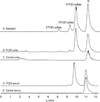Identification of sulfated metabolites of 4-chlorobiphenyl (PCB3) in the serum and urine of male rats
- PMID: 23137097
- PMCID: PMC3524396
- DOI: 10.1021/tx300416v
Identification of sulfated metabolites of 4-chlorobiphenyl (PCB3) in the serum and urine of male rats
Abstract
Polychlorinated biphenyls (PCBs) are legacy pollutants that exert toxicities through various mechanisms. In recent years exposure to PCBs via inhalation has been recognized as a hazard. Those PCBs with lower numbers of chlorine atoms (LC-PCBs) are semivolatile and have been reported in urban air, as well as in the indoor air of older buildings. LC-PCBs are bioactivated to phenols and further to quinone electrophiles with genotoxic/carcinogenic potential. We hypothesized that phenolic LC-PCBs are subject to conjugation and excretion in the urine. PCB3, often present in high concentrations in air, is a prototypical congener for the study of the metabolism and toxicity of LC-PCBs. Our objective was to identify metabolites of PCB3 in urine that could be potentially employed in the estimation of exposure to LC-PCBs. Male Sprague-Dawley rats (150-175 g) were housed in metabolism cages and received a single intraperitoneal injection of 600 μmol/kg body weight of PCB3. Urine was collected every 4 h; rats were euthanized at 36 h; and serum was collected. LC/MS analysis of urine before and after incubation with β-glucuronidase and sulfatase showed that sulfate conjugates were in higher concentrations than glucuronide conjugates and free phenolic forms. At least two major metabolites and two minor metabolites were identified in urine that could be attributed to mercapturic acid metabolites of PCB3. Quantitation by authentic standards confirmed that approximately 3% of the dose was excreted in the urine as sulfates over 36 h, with peak excretion occurring at 10-20 h after exposure. The major metabolites were 4'PCB3sulfate, 3'PCB3 sulfate, 2'PCB3 sulfate, and presumably a catechol sulfate. The serum concentration of 4'PCB3 sulfate was 6.18 ± 2.16 μg/mL. This is the first report that sulfated metabolites of PCBs are formed in vivo. These findings suggest a prospective approach for exposure assessment of LC-PCBs by analysis of phase II metabolites in urine.
Conflict of interest statement
The authors state that there is no conflict of interest.
Figures







References
-
- Jones KC, de Voogt P. Persistent organic pollutants (POPs): state of the science. Environ. Pollut. 1999;100:209–221. - PubMed
-
- Burreau S, Zebuhr Y, Broman D, Ishaq R. Biomagnification of PBDEs and PCBs in food webs from the Baltic Sea and the northern Atlantic ocean. Sci. Total Environ. 2006;366:659–672. - PubMed
-
- Breivik K, Sweetman A, Pacyna JM, Jones KC. Towards a global historical emission inventory for selected PCB congeners--a mass balance approach. 1. Global production and consumption. Sci. Total Environ. 2002;290:181–198. - PubMed
-
- Consonni D, Sindaco R, Bertazzi PA. Blood levels of dioxins, furans, dioxin-like PCBs, and TEQs in general populations: A review, 1989–2010. Environ. Int. 2012;44:151–162. - PubMed
Publication types
MeSH terms
Substances
Grants and funding
LinkOut - more resources
Full Text Sources

